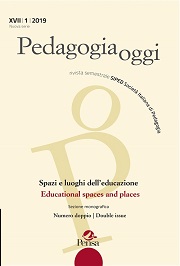Physical and symbolic spaces in the educational work of the Italian oratories between the nineteenth and twentieth centuries
Abstract
At the end of the XIX and beginning of the XX centuries, Catholic priests and educators with pastoral responsibility for young people made various attempts to define the educational identity and organizational structure of the Italian oratories, carefully planning the spaces in which boys and young men were brought together, especially on Sundays, for religious instruction, prayer, games and entertainment. Following on from some of the most recent examples of educational historiography, this contribution aims to describe those spaces, considering not only their physical features but also their symbolic meanings. The sources analyzed reveal the guidelines for setting up oratories and the use to which the various spaces within them were to be put, thus helping us to interpret these spaces in light of the (sometimes implicit) pedagogical perspectives that inspired them.




